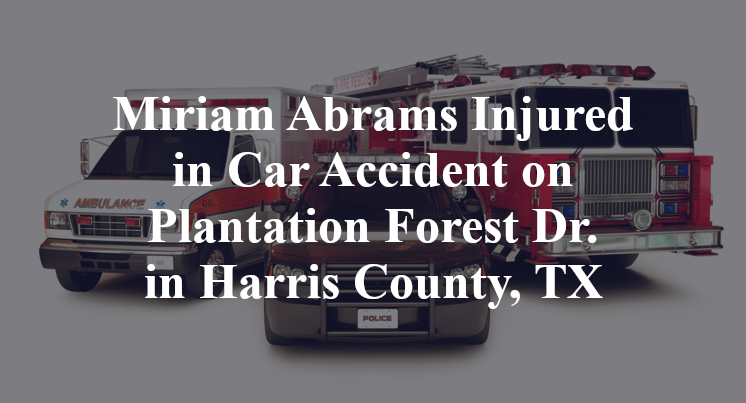Miriam Abrams Injured in Car Accident on Plantation Forest Dr. in Harris County, TX
Harris County, TX — July 3, 2024, Miriam Abrams was injured due to a car accident just before 4:45 p.m. along Plantation Forest Drive.
According to authorities, 57-year-old Miriam Abrams was traveling in a northbound Honda Pilot on Plantation Forest Drive at the Rum River Court intersection when the accident took place.

Officials indicate that, for as yet unknown reasons, a westbound Kia Forte entered the intersection at an apparently unsafe time, failing to yield the right-of-way at a stop sign. A collision consequently occurred between the front-end of the Pilot and the front-left quarter of the Forte.
Abrams reportedly sustained serious injuries over the course of the accident; she was transported to an area medical facility by EMS in order to receive necessary treatment. Additional details pertaining to this incident are not available at this point in time.
Commentary by Attorney Michael Grossman
Crashes at neighborhood intersections often seem straightforward—one driver goes when they shouldn’t, another has the right-of-way, and a collision follows. But just because fault looks obvious doesn’t mean the story ends there. When someone gets seriously hurt, it’s worth slowing down to ask what might still be unanswered.
1. Did the authorities thoroughly investigate the crash?
Accidents at residential intersections are often treated with less urgency, but a serious injury demands a closer look. Were speed estimates calculated for both vehicles? Did officers analyze how far into the intersection the Forte made it before the impact? A diagram alone won’t show whether the stop was rolled, missed entirely, or mistimed. It also matters whether the investigation included interviews with neutral witnesses or camera footage from nearby homes—because relying only on what the drivers said may leave out key details.
2. Has anyone looked into the possibility that a vehicle defect caused the crash?
It’s possible the Kia Forte failed to stop because of brake issues, throttle problems, or a sensor malfunction. These things aren’t always visible to the eye, especially after a crash. A misfire in automatic stop-start systems or lane-keeping tech can sometimes contribute without the driver realizing. If no one inspects the Kia for potential defects, those possibilities stay buried—and an injured person is left with a partial picture.
3. Has all the electronic data relating to the crash been collected?
Both vehicles likely have systems that logged pre-crash data—speed, brake use, steering angle, and acceleration. If that information wasn’t retrieved, then part of the truth is still sitting inside those cars. Beyond the onboard tech, traffic or doorbell cameras nearby might provide additional clarity. Even phone records, if either driver was distracted, can help explain a moment that otherwise seems like a simple misjudgment.
People tend to treat neighborhood crashes like minor fender-benders, even when the injuries say otherwise. But when something serious happens, it deserves a serious effort to get the facts right.
Takeaways:
- Injury crashes at intersections need detailed reviews of timing, speed, and vehicle positions.
- Brake or sensor malfunctions could cause a driver to enter traffic unintentionally.
- Onboard data and local surveillance footage can confirm key actions and possible distractions.

*We appreciate your feedback and welcome anyone to comment on our blog entries, however all visitor blog comments must be approved by the site moderator prior to showing live on the site. By submitting a blog comment you acknowledge that your post may appear live on the site for any visitors to see, pending moderator approval. The operators of this site are not responsible for the accuracy or content of the comments made by site visitors. By submitting a comment, blog post, or email to this site you acknowledge that you may receive a response with regard to your questions or concerns. If you contact Grossman Law Offices using this online form, your message will not create an attorney-client relationship and will not necessarily be treated as privileged or confidential! You should not send sensitive or confidential information via the Internet. Since the Internet is not necessarily a secure environment, it is not possible to ensure that your message sent via the Internet might be kept secure and confidential. When you fill out a contact or comment form, send us an email directly, initiate a chat session or call us, you acknowledge we may use your contact information to communicate with you in the future for marketing purposes, but such marketing will always be done in an ethical way.